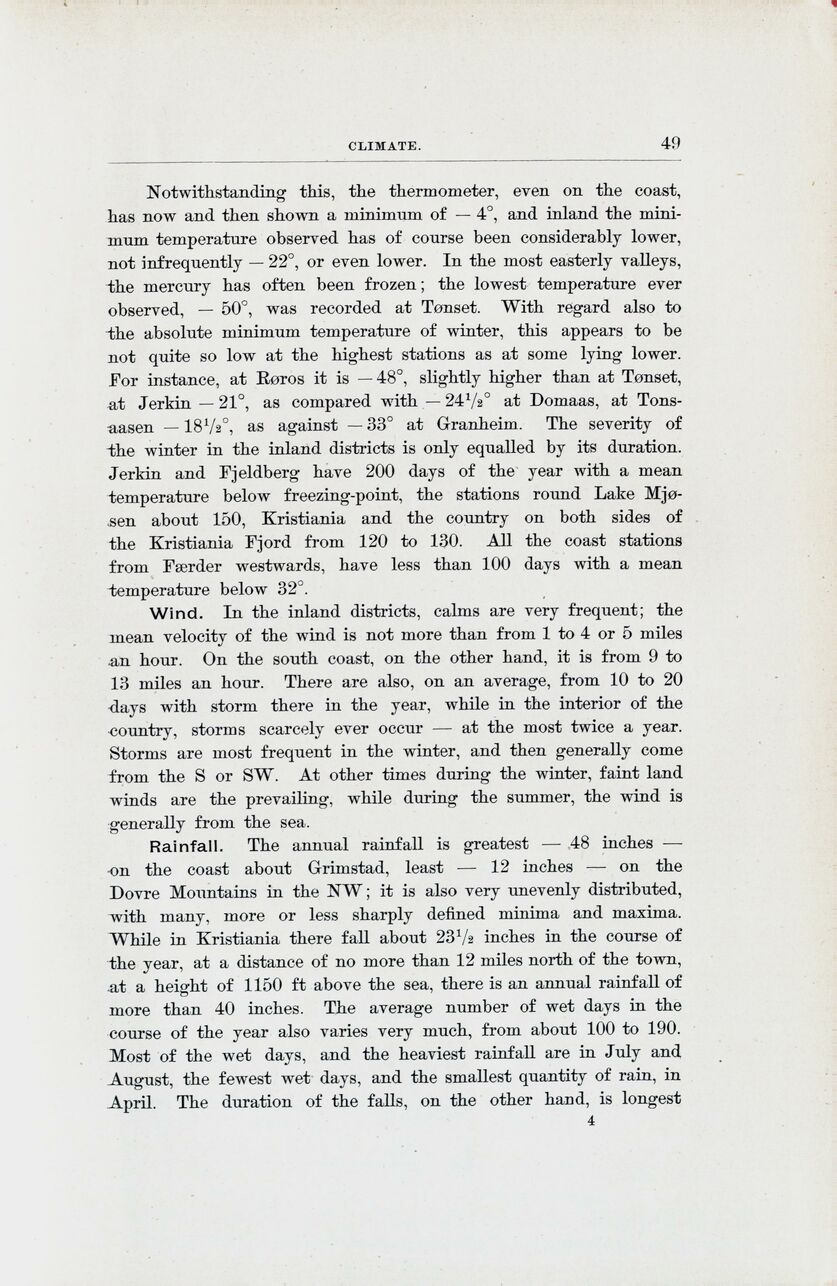
Full resolution (JPEG) - On this page / på denna sida - Climate, by Axel Steen

<< prev. page << föreg. sida << >> nästa sida >> next page >>
Below is the raw OCR text
from the above scanned image.
Do you see an error? Proofread the page now!
Här nedan syns maskintolkade texten från faksimilbilden ovan.
Ser du något fel? Korrekturläs sidan nu!
This page has been proofread at least once.
(diff)
(history)
Denna sida har korrekturlästs minst en gång.
(skillnad)
(historik)
Notwithstanding this, the thermometer, even on the coast,
has now and then shown a minimum of −4° and inland the
minimum temperature observed has of course been considerably lower,
not infrequently −22°, or even lower. In the most easterly valleys,
the mercury has often been frozen; the lowest temperature ever
observed, −50°, was recorded at Tønset. With regard also to
the absolute minimum temperature of winter, this appears to be
not quite so low at the highest stations as at some lying lower.
For instance, at Røros it is −48°, slightly higher than at Tønset,
at Jerkin −21°, as compared with −24 ½° at Domaas, at
Tonsaasen −18 ½° as against −33° at Granheim. The severity of
the winter in the inland districts is only equalled by its duration.
Jerkin and Fjeldberg have 200 days of the year with a mean
temperature below freezing-point, the stations round Lake
Mjøsen about 150, Kristiania and the country on both sides of
the Kristiania Fjord from 120 to 130. All the coast stations
from Færder westwards, have less than 100 days with a mean
temperature below 32°.
Wind. In the inland districts, calms are very frequent; the
mean velocity of the wind is not more than from 1 to 4 or 5 miles
an hour. On the south coast, on the other hand, it is from 9 to
13 miles an hour. There are also, on an average, from 10 to 20
days with storm there in the year, while in the interior of the
country, storms scarcely ever occur — at the most twice a year.
Storms are most frequent in the winter, and then generally come
from the S or SW. At other times during the winter, faint land
winds are the prevailing, while during the summer, the wind is
generally from the sea.
Rainfall. The annual rainfall is greatest — 48 inches —
on the coast about Grimstad, least — 12 inches — on the
Dovre Mountains in the NW; it is also very unevenly distributed,
with many, more or less sharply defined minima and maxima.
While in Kristiania there fall about 23 ½ inches in the course of
the year, at a distance of no more than 12 miles north of the town,
at a height of 1150 ft above the sea, there is an annual rainfall of
more than 40 inches. The average number of wet days in the
course of the year also varies very much, from about 100 to 190.
Most of the wet days, and the heaviest rainfall are in July and
August, the fewest wet days, and the smallest quantity of rain, in
April. The duration of the falls, on the other hand, is longest
<< prev. page << föreg. sida << >> nästa sida >> next page >>